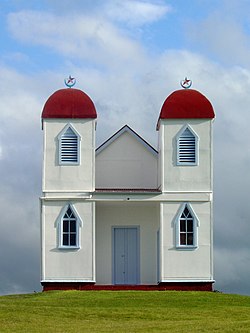Ratana

The Ratana Movement is a syncretistic religious and political movement founded by TW Ratana (1873–1939) in New Zealand at the beginning of the 20th century . The headquarters of the Ratana Church is in the small town of Ratana near Wanganui .
Starting position of the Māori
The situation of the Māori during the first decades of the 20th century was very bad. As a result of the numerous wars , the number of Maori has been greatly decimated. Since the middle of the 19th century they have gradually lost their cohesion among the tribes , their original lands, their traditional customs and religions, and their mana . On the one hand, many Māori accepted Christianity with its commandments and ideas. On the other hand, they had an extremely divided relationship with the missionaries who spread this new doctrine. They themselves did not always act "Christian", but rather "made pacts" with the white government. Clergymen were even accused of acting as government agents to promote the suppression of the Māori. Since the 1860s, various Māori preachers began to interpret the Bible in such a way that it was also accessible to the Māori.
The Ratana Church
The first pillar of the Ratana movement is religion ( Te Reo Māori : Ture Wairua ). In 1918, Tahupotiki Wiremu Ratana (TW Ratana) had a vision - in his opinion God-given - in which he was asked by God to bring the Māori closer to the Gospel , to destroy the power of the Tohunga (e.g. the healer) and to heal the body and mind of his people. However, the Ratana religion contains many elements of the traditional Māori religion ; a key cause of its popularity among the natives. Until 1924 Ratana preached to an increasing number of listeners and referred to himself as "Maori Miracle Man" ( German : Maori miracle man ). Initially, this movement was viewed as a Christian revival movement , but soon it moved away from the then existing churches. On May 31, 1925, the Te Haahi Ratana Church was officially founded and its founder was confirmed as Te Mangai or “God's mouthpiece”.
The secular movement
Origins
The second pillar of the Ratana movement is worldly activities (Te Reo Māori: Ture Tangata ). After a specially formed church committee was responsible for all religious areas of the Ratana Church from 1924, TW Ratana was able to turn away from church matters and turn to the secular problems of his followers (Te Reo Māori: morehu ). In 1924, Ratana started a trip to Europe with other Maori to petition King George V and the League of Nations about the confiscation of land and other injustices related to the Treaty of Waitangi by the white settlers and the government undo. This trip was just as unsuccessful as others to the United States , Canada and Japan . These projects were very controversial in New Zealand.
With the completion of the Te Temepara Tapu o Ihoa , a church building, in 1928, Ratana declared his religious work finally over. Ratana wanted to have a say in politics in New Zealand as early as 1923. He described the four seats in parliament reserved for Māori as "quarters of his body". His eldest son competed unsuccessfully as a representative of the Western Maori . Now Ratana was determined to win the Māori seats for his movement. In the parliamentary elections of 1928 and 1931 he failed with his goal, but was able to win two seats ( Western Maori and Southern Maori ) in 1935 .
Political goals
In general, the Ratana Party was the first political association in the country's history, consisting largely of Māori. Above all, she campaigned for a legally enshrined recognition of the Treaty of Waitangi, the return of lands and social equality between Maori and Pākehā .
Alliance with the Labor Party
When, after the election in 1935, the Labor Party under Michael Joseph Savage formed the government for the first time, the two Ratana MPs agreed to form an alliance with the Labor Party. This was officially sealed when the two MPs presented Prime Minister Savage with four symbolic gifts: a potato , a broken gold watch, a he -tiki made of greenstone (Te Reo Māori: Pounamu ; a type of jade , more precisely a nephrite ) and the feather of a Huia . The potato symbolized the loss of Māori lands, the clock symbolized broken promises, the Hei-tiki (a kind of necklace) the Māori mana . If Savage could restore these three things, he would be entitled to wear the Huia feather, which symbolizes his high status. This handover was judged to be so seminal that things were put in Savage's grave when he was buried in 1940.
In the following years the seats for the Northern and Eastern Maori were won and held in part until the reform of the electoral system in 1996.
Influence on New Zealand politics
In the parliaments from 1946 to 1948 and from 1957 to 1960, the Ratana deputies were decisive for the formation of a government. Although not all Labor Māori MPs were members of the Ratana Church, the alliance with Ratana allowed the Labor Party to claim all four Māori seats from the 1940s to 1996. Since then, the Labor Party has no longer “ruled” the Ratana MPs, but the movement still plays an important role in New Zealand politics. All MPs and ministers of the Labor Party regularly attend the annual celebrations for TW Ratana's birthday. In 2006, the two co-chairs of the Māori Party, Tariana Turia and Pita Sharples , Don Brash as chairman of the National Party and Winston Peters as chairman of New Zealand First appeared .